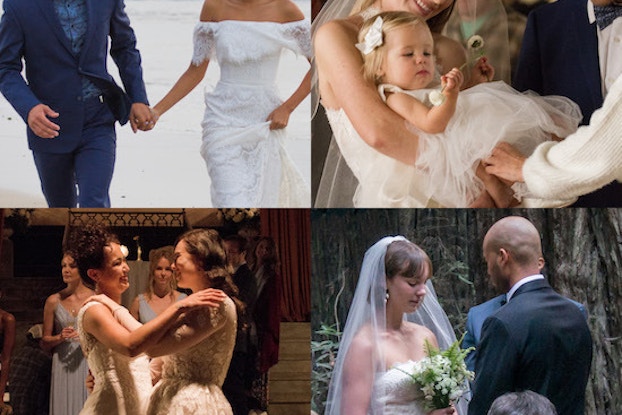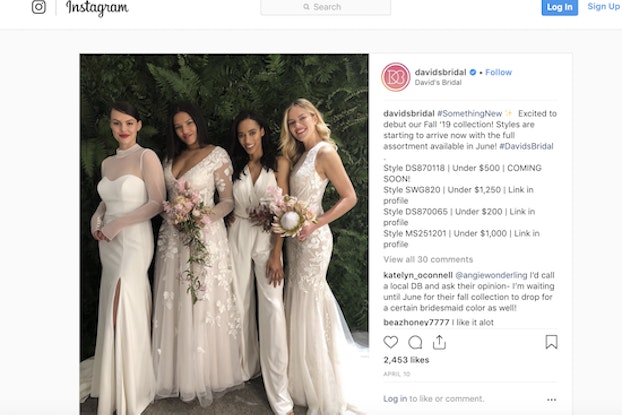
To understand how David’s Bridal, which in January emerged from an eight-week stint in bankruptcy, is aiming for newfound relevance amid a vastly changed consumer base and wedding market, one need only look to its recent ad campaign for clues.
It features a bride with blue nail polish, a same-sex couple, a couple with a baby and one getting married in a forest. The TV spots also live on YouTube and throughout the retailer’s digital channels, just as its shoppers do.
Like the ad, internally dubbed, “rewrite the rules,” David’s Bridal is intent on striking an authentic emotional chord as it sends an unequivocal message: “We have to be inclusive and serve the diversity of brides, no matter her partner, size, style of wedding or budget,” Liz Crystal, chief marketing officer, told CO—.
That’s all pivotal to resonating with today’s millennial and Generation Z brides, who also crave opportunities for self-expression and Instagrammable moments.
The strategy reflects the casualization of the wedding market that’s been simmering for decades and extends across consumer products. It has dinnerware and cutlery makers rethinking a business built around the china cabinet-furnished dining rooms of a bygone era, and has bridal apparel merchants catching up with the lifestyles of a burgeoning generation of shoppers.
Indeed, today’s modern bride might still don a cummerbund ballgown, but could also be found sporting a crepe jumpsuit with sneakers. She might say her vows in church but might also utter “I do” on the beach or in a barn, Crystal said.
Sizing up the bridal market
The rise of unconventional wedding practices like non-diamond engagement rings and wedding dresses that depart from tradition, coupled with a falling marriage rate in the United States, have pressured legacy retailers like David’s Bridal, making it tougher to compete, according to an IBISWorld report.
“Although the vast majority of weddings will still conform to tradition to some degree, the declining marriage rate and slight shift toward nontraditional weddings pose a threat to operators who are not able to adequately adjust,” the report said.
It’s in part why David’s Bridal stumbled. “We were not moving fast enough to compete in the marketplace,” Crystal said.
With Chapter 11 behind it and after unloading $450 million in debt, “We’re better positioned to now compete in the marketplace and build our business,” Crystal said.
That market has no doubt changed.

While local independent boutiques remain a competitive constant, the encroachment of bridal startups along with high-profile exits has shaken up the business.
The last few years saw the demise of bridal retailer Alfred Angelo, the closure of Gap-acquired startup Weddington Way, just as J.Crew ended its ready-to-wear wedding gown business.
Meanwhile, “the increase in online players has of course made an impact on the industry,” Crystal said. These include direct-to-consumer newbies like Anomalie, which offers the promise of customized gowns at a value, and Floravere, which touts luxury couture looks at “shockingly” affordable prices.
While newbies have whipped up disruptor buzz, David’s Bridal still dominates the wedding dress business with a 27.3% share, according to an IBISWorld report. And one in three brides buys from the retailer, notes Crystal.
Crystal sees an opportunity to protect that market share lead by capitalizing on the 300-store chain’s “unique points of differentiation” as the only national full-service bridal retailer in the United States with stylists, value-priced dresses ranging from $99 to $2,000 and a “head-to-toe, 24/7 shopping experiences online” that includes Blueprint, the gift registry startup it acquired in 2018.
To sharpen its competitive edge, it’s tying that niche to “key pillars” — a contemporary product assortment that embraces a multi-ethnic, lifestyle and size-inclusive ethos for today’s digital native brides, she said.
We were not moving fast enough to compete in the marketplace.Liz Crystal, chief marketing officer, David's Bridal
Telling emotional, contemporary stories
But it’s a new attention to baking emotional resonance, personalization and authenticity into the entire wedding shopping experience at David’s Bridal that is the crux of Crystal’s marketing strategy.
It’s why the retailer eschewed its usual in-store-shot TV spot in favor of a commercial depicting real-life, modern day wedding scenarios, why its social media feed spotlights the photos and musings of everyday brides, why it’s touting decidedly non-matchy-matchy bridesmaids’ dresses aimed to flatter all figures and skin tones, and why its bridal guides are sanctioning an unshackling from tradition, if that’s what the bride craves, with messages like, “Be your own bride,” and, “Because there’s no couple like the two of you, and no celebration like your wedding.”
It’s a strategy that culls from Crystal’s career at companies from Disney to Revlon, “consumer brands that have an emotional component,” she said, that’s now, fittingly, making its imprint on David’s Bridal, a business built around a quintessentially heart-tugging rite of passage: the wedding day.
Revlon founder Charles Revson famously spoke of his beauty products as "hope in a jar," noted Crystal. “It’s about delivering confidence to the consumer — you have to remember the end use and the feeling you give to the consumer to connect with her.”
Part of connecting with today’s bride is about disabusing her of any notions she might have of David’s Bridal as a dated brand. “We are known for our traditional gowns,” Crystal said. But getting them to understand that David’s Bridal is contemporary and trend-right is critical to capturing millennials and Generation Z, according to research the brand conducted.
“Contemporary is really the number one thing,” Crystal said. “From a macro perspective, it’s how they’re approaching their lifestyle,” which is reflected in the generations’ product preferences and what they expect from how they interact with brands, she said.
To that end, David’s Bridal is working more quickly to churn out the right fashion at the right time. “The idea is to deliver against all of the fashion trends ... in all sizes,” she said.
To make good on that promise, Crystal, who previously served as chief marketing officer of plus-sized apparel merchant Lane Bryant, said the retailer, which already carries a broad selection of plus sizes, is adding even more sizes and style options to the mix, just as it incorporates plus-sized imagery more frequently and organically into all of its marketing. “It really doesn’t need to be called out,” she said. “It really doesn’t matter what size it is.”

During a walk-through of David’s Bridal’s Fall 2019 collection at a store in Manhattan’s Chelsea neighborhood, that contemporary push was on full display — from the styles donned by the models to the sensibility imparted by a look.
With sexier bridal looks trending, Crystal and Lori Conley, senior vice president of merchandising, design and product development, highlighted new dresses with sheer bodices that have been “a huge win” in all sizes, as women today are increasingly celebrating their curves amid the body positivity movement, Conley said.
The collection included “grown-up bohemian” looks from David Bridal’s exclusive Melissa Sweet line, dresses that reflect the “anti-sparkle trend,” spats with a chunky heel or rhinestone flats for brides who are “forgoing stilettos,” and dresses lined with a new “Spanx-like” power mesh material akin to what’s typically found in pricey gowns for added comfort. It’s all about light, airy and collapsible looks that echo the “unencumbered-by-the-garment” inclinations of today’s brides, Conley said.
“And [the bride] is looking to personalize everything,” Crystal said.
To be culturally relevant today, brands like David’s Bridal must appeal to every woman on her terms, said Marie Chan, a partner with global consultancy Vivaldi Group, which counts brands like Disney, Airbnb and Samsung among its clients. “How tired are we of the size four woman wearing a princess gown overflowing with taffeta? Celebrating inclusivity and diversity amongst the bridal market is like a breath of fresh of air,” she said.
Building a modern experience for the digitally-wired bride
When Crystal joined David’s bridal in January 2018, she was also charged with reaching consumers at all their touch points, be it in stores or on their smartphones.
For the retailer, social media has become invaluable to tracking customer preferences, while asserting its bridal authority and credibility. “We are an authentic brand and always have been,” Crystal said. “How do we show that? Through our social media feed, which has become an important growth area for us and is how [the bride] does her research.
“That research tells us that more and more brides and their bridal parties start with Instagram and Pinterest for wedding inspiration and planning,” which have become critical peer-sharing platforms for the retailer, she said.
Shoppers also seek inspiration from user-generated content (UGC), “which we feature frequently to take advantage of the peer-to-peer influence consumers demand.”
It turns out that consumers who engage with David’s Bridal on social first are more likely to ultimately make a purchase, she said.
The retailer monitors shopper feedback from its social posts daily, input that then informs the merchandise assortment. “What we have found is that these [social media] comments and engagement scores are often an indicator of the sales success of a gown,” Crystal said. “For example, if we see that a limited-buy style is very well received on social, we may decide to bring it into more stores.”
“We have to understand who our customer is,” Crystal said. While she’s a bride to be, “she wakes up as a person first.”
CO— aims to bring you inspiration from leading respected experts. However, before making any business decision, you should consult a professional who can advise you based on your individual situation.
CO—is committed to helping you start, run and grow your small business. Learn more about the benefits of small business membership in the U.S. Chamber of Commerce, here.






